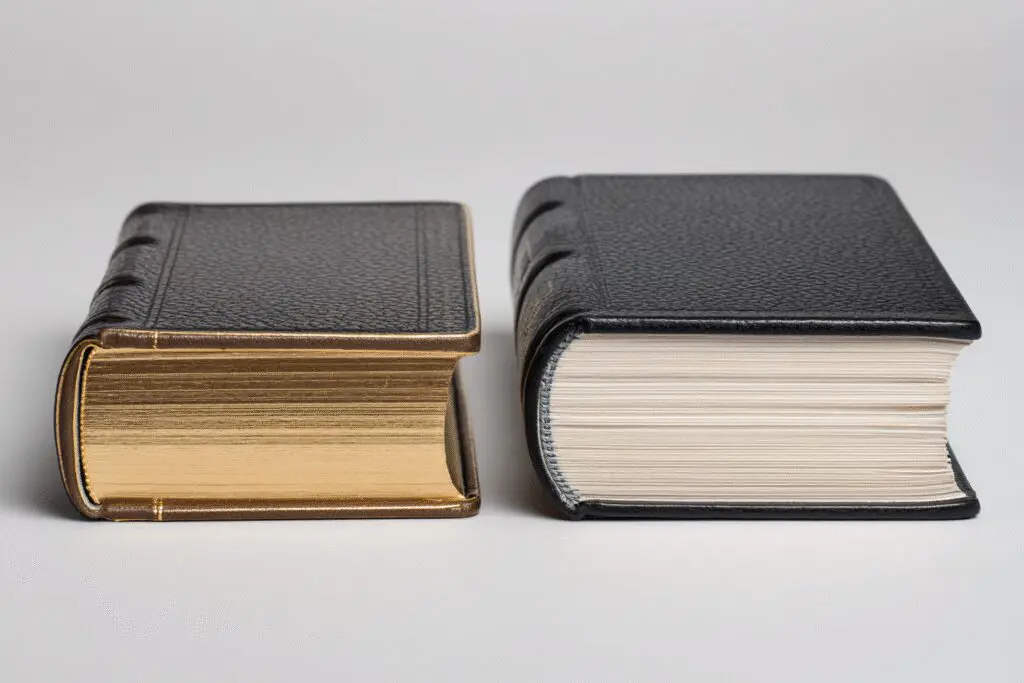I remember my first “real” Bible. It was a gift for my confirmation. This thing was a beast. It was a thick, heavy study Bible with tiny print, maps, and what felt like a million footnotes. I loved it, but I rarely took it anywhere. It stayed on my desk. It was just too big to carry to a friend’s house, on vacation, or to a coffee shop.
Then, one day, I saw a friend pull a Bible out of her purse. It was slim. It was light. It looked… usable. That was my first introduction to the world of thinline Bibles.
So, what is a thinline Bible? Simply put, it’s a Bible designed specifically to be thin and portable. It’s built to be your companion, the Bible that actually leaves the house with you. It’s not about cramming in the most features. It’s about making God’s Word accessible wherever you go. This guide is here to walk you through what they are, who they’re for, and how you can find the perfect one for your journey.
More in Bible Category
What Is the Best Cross Reference Bible
What Is the Best Translation of the Bible
Key Takeaways
- What is a Thinline Bible? A Bible designed to be exceptionally thin, typically around one inch thick or less, for maximum portability.
- How are they made? They use very thin, high-quality Bible paper, smart layout choices, and often flexible covers to reduce bulk.
- Who are they for? They are perfect for students, travelers, commuters, or anyone who wants a Bible for daily carry, outreach, or focused reading without distractions.
- What are the trade-offs? The print can be smaller, and they lack the extensive notes found in study Bibles. Durability can also vary based on materials.
- How to choose one? Consider the translation you prefer, the quality of the paper and binding, and the feel of the cover material.
What Exactly Makes a Bible “Thinline”?
The term “thinline” might sound technical, but it’s really more of a description. It tells you the main goal of the Bible’s design: to be slim. There isn’t a strict, industry-wide rule that says a Bible must be 0.99 inches to qualify. However, you’ll find most Bibles marketed this way are right around that one-inch mark.
This focus on slimness affects every part of the Bible’s construction, from the paper to the font.
How Do They Make the Bibles So Slim?
Creating a thin Bible is a careful balancing act. Publishers have to make smart choices to shrink the size without making the Bible impossible to read or causing it to fall apart after a few months.
It really comes down to a few key areas:
- Bible Paper: This is the biggest factor. They use a special, very thin paper that is still strong and opaque enough to prevent too much text from showing through from the other side. This is why you can’t just print the Bible on regular copy paper; it would be the size of a phone book!
- Layout and Font: Designers carefully arrange the text on the page. They might use a font that is slightly more condensed or reduce the space between lines. The goal is to fit the same sacred words into a smaller physical space.
- Minimal Features: Thinline Bibles usually don’t have wide margins for note-taking. They also have far fewer study notes, cross-references, and articles than a full study Bible. They are designed for reading, not for deep academic study.
Is There a Standard Thickness for a Thinline Bible?
No, there isn’t an official rulebook for this. “Thinline” is a marketing term used by publishers like Zondervan, Crossway, and Thomas Nelson to signal that a Bible is much thinner than a standard version.
Generally, you can expect a thinline Bible to be about one inch thick or less. Some might be a little more, some a little less. This is a huge difference compared to many popular study Bibles, which can easily be two inches thick or even more. The difference in weight and bulk is immediately noticeable the first time you hold one.
Why Would Someone Choose a Thinline Bible Over a Regular One?
I have a whole shelf of Bibles at home. I have big, heavy study Bibles for when I’m digging deep into a passage. I have historical Bibles. But the one that gets the most use is my simple, leather thinline Bible. The reason is simple. It’s the one that’s with me.
The benefits of a thinline Bible are very practical and can honestly change how you interact with God’s Word every day.
Are Thinline Bibles Easier to Carry Around?
Absolutely. This is their number one selling point. The difference is night and day. A thinline Bible feels less like a textbook and more like a journal or a novel. This portability opens up so many opportunities to engage with Scripture.
Here’s why that matters so much:
- It fits in your bag. For me, this was the game-changer. I can slip it into my work bag, a backpack, or even a larger coat pocket. There is no excuse for it not to be with me.
- It’s lightweight. You barely notice the extra weight when traveling or commuting. This makes it perfect for mission trips, vacations, or just your daily bus ride.
- It’s approachable. Sometimes, pulling out a massive Bible can feel a little intimidating, either to you or to the people around you. A thinline is discreet and feels more personal and less formal.
Can a Simpler Bible Help You Focus More on Reading?
This was a surprise benefit for me. My study Bible is incredible, but all the notes, charts, and references in the margins can sometimes be distracting. My eyes wander down the page, and before I know it, I’m reading a footnote about Greek verbs instead of just letting the story of David and Goliath wash over me.
A thinline Bible presents the text of Scripture with minimal interruption. It invites you to simply read. You can read entire chapters, even entire books, in one sitting without being pulled away by commentary. It encourages a different kind of reading—more devotional, more immersive. It helps you see the big picture of God’s story.
Who Are Thinline Bibles Really For?
While anyone can enjoy a thinline Bible, they are especially perfect for certain people and situations. They are a wonderful tool for:
- Students: Easy to carry from class to class or to a campus Bible study.
- Travelers and Commuters: Lightweight and slim for packing in a suitcase or carrying on public transport.
- New Christians: A thinline can feel much less overwhelming than a giant study Bible. It’s a great starting point.
- Pastors and Speakers: A great option for carrying up to the pulpit. It’s easy to hold and manage while speaking.
- Outreach and Evangelism: Easy to carry with you in case an opportunity arises to share Scripture with someone.
- Anyone wanting a “second Bible”: Many people own a large study Bible for home and a thinline for everything else.
Are There Any Downsides I Should Be Aware Of?
Of course, no Bible is perfect for every single purpose. The very design choices that make a thinline Bible so slim and portable also create a few trade-offs. It’s important to be honest about these so you can make the right choice for you. I certainly don’t use my thinline when I’m preparing a deep lesson; I use a different tool for that job.
Is the Text in a Thinline Bible Hard to Read?
This is probably the most common concern. To make the Bible thin, something has to give, and often that’s the font size. The text in a thinline is almost always smaller than in a standard or large-print Bible. For people with vision challenges, this can be a real problem.
Another issue that can come up is “ghosting.” This is when you can see the text from the other side of the page bleeding through. It happens because the paper is so thin. However, many high-quality thinline Bibles solve this problem with a feature called “line matching.” This means the lines of text are printed in the exact same spot on both sides of the page, which makes ghosting much less noticeable.
Will I Miss Having Study Notes and References?
If you are accustomed to having notes at the bottom of every page, then yes, you will probably miss them at first. Thinline Bibles are not meant to be exhaustive resources. They strip away the commentary to prioritize the biblical text itself.
I’ve learned to see this as a feature, not a bug. It forces me to wrestle with the text on my own before looking for answers. And with modern technology, if I have a question, I can always pull out my phone and look up a commentary. For me, my thinline is for reading and reflection, and my other tools are for deep study.
How Durable Are These Slimmer Bibles?
Durability really depends on the quality of the materials used, just like with any other Bible. Because they are designed to be carried around, they can be subject to more wear and tear.
The two most important factors for durability are the binding and the cover.
- Binding: Look for a Bible with a “smyth-sewn” binding. This means the pages are stitched together in bundles, making the Bible extremely durable and allowing it to lay flat when open. A cheaper, “glued” binding is more rigid and can fall apart over time.
- Cover: A genuine leather cover will last for decades and only get better with age. However, many modern imitation leather options, often called “Leathersoft” or “TruTone,” are very durable and feel great for a much lower price. A simple paperback or hardcover will be the least durable option for a Bible you plan to carry daily.
How Do I Choose the Best Thinline Bible for Me?
Choosing a Bible is a wonderfully personal decision. The “best” one isn’t the most expensive one. It’s the one you will actually pick up and read. When you’re looking for a thinline, it’s about finding the right combination of readability, portability, and quality that fits your needs and your budget.
After looking at dozens over the years for myself and for friends, I’ve found it helps to focus on a few key questions.
Which Bible Translation Should I Look For?
This is the most important question. The translation determines how the original Hebrew and Greek texts are rendered in English. There are many great options, and they generally fall on a spectrum.
- Word-for-Word (More Formal): These translations try to stick as closely as possible to the structure and wording of the original languages. Examples include the English Standard Version (ESV), the New American Standard Bible (NASB), and the King James Version (KJV). They are excellent for close study.
- Thought-for-Thought (More Dynamic): These translations focus on conveying the original meaning of a passage in natural, modern English. Examples include the New International Version (NIV) and the New Living Translation (NLT). They are often praised for their readability.
My advice? Don’t get paralyzed by the options. Go online and read a familiar chapter, like John 3 or Psalm 23, in a few different translations. Pick the one that speaks to you clearly and that you find yourself enjoying.
What Should I Know About Paper and Print Quality?
This is where you can really feel the difference between a cheap Bible and a quality one. The history of printing Bibles is a story of incredible craftsmanship. For centuries, people have worked to make the text both beautiful and clear. You can even see examples of historical Bible printing in university collections, like the one at the University of Arizona Libraries.
When you are looking at a thinline, pay attention to:
- Paper Opacity: How much text shows through from the other side? Higher quality paper will be more opaque, even when it’s thin.
- Line Matching: As mentioned before, this is a huge help for readability. Look for it in the product description.
- Print Size: The font size is usually listed in points (e.g., 8-point, 9.5-point). Be realistic about what your eyes can handle comfortably. If you can, try to see it in person or look for online reviews that show pictures of the text.
What’s the Big Deal with Binding and Cover Materials?
The binding and cover determine how the Bible feels in your hands and how well it will hold up over time.
- Binding: I will always recommend a smyth-sewn binding. It’s the gold standard for quality. It lets the Bible lay flat on a table, which is a bigger deal than you might think. Glued bindings are stiff and prone to cracking.
- Cover Materials: You have lots of choices here, at every price point.
- Goatskin or Top-Grain Leather: These are premium, super soft, flexible, and extremely durable. They are an investment that will last a lifetime.
- Genuine Leather: This is a solid, durable choice. It can be a bit stiff at first but softens nicely over time.
- Imitation Leather (Leathersoft, TruTone, etc.): This is the sweet spot for many people. Modern imitation leathers are surprisingly soft, flexible, and durable, offering a premium feel without the premium price.
- Hardcover: A good budget option, but it can be bulky and the corners can get damaged with heavy use.
Are There Any Special Features to Look For?
Even though thinline Bibles are minimalist, they can still have a few helpful features.
- Red Letter Text: This is when the words of Jesus are printed in red ink. Many people find this very helpful for reading the Gospels.
- Ribbon Markers: Most thinline Bibles come with one or two ribbon markers. These are essential for keeping your place.
- Concordance: This is like a small index of important words in the Bible. The concordances in thinline Bibles are usually very limited, but they can still be helpful for finding a familiar verse.
A Personal Reflection on My Thinline Bible
There is something powerful about a Bible that bears the marks of your own journey. My thinline Bible has been bent, folded, and rained on. It’s been with me in moments of quiet joy and in hospital waiting rooms. The cover is soft and worn, and the pages are creased at my favorite psalms.
It’s not the fanciest Bible on my shelf. It doesn’t have the most scholarly notes. But it’s the Bible that has heard my prayers in the park and my questions on the train. Its portability didn’t just make it easier to carry; it made it easier to live with. It integrated God’s Word into the normal, everyday rhythm of my life.
The Best Bible Is the One You Read
In the end, all of these details about paper and binding are secondary. The goal is to find a Bible that you will love to open. A thinline Bible is a beautiful invitation to do just that. It removes the barrier of size and weight, making it easier than ever to bring the Word of God with you, wherever He leads you.
Whether you are a lifelong believer or just beginning to explore faith, a thinline Bible can be a wonderful and practical tool. It’s a constant, physical reminder of God’s presence, ready to offer guidance, comfort, and wisdom, right from your backpack.
Frequently Asked Questions – What Is a Thinline Bible

Are there any downsides to using a thinline Bible?
Yes, some downsides include the smaller font size, which may be difficult for individuals with vision challenges, and the thin paper that can cause ghosting, where text from the opposite side of the page faintly shows through. It also lacks extensive study notes, which might be a drawback for deep study.
What should I consider when choosing a thinline Bible?
When choosing a thinline Bible, consider the translation that best suits your reading needs, the cover material for durability and feel, paper quality to minimize ghosting, font size for readability, layout style, and additional features such as ribbons or maps to enhance your reading experience.
What are the main benefits of using a thinline Bible?
The main benefits of a thinline Bible include its portability, ease of handling, and reduced weight, making it ideal for daily reading, church, travel, or on-the-go use. Its simpler layout also helps maintain focus on the scripture without distraction from extensive notes or features.
How does a thinline Bible compare to a compact Bible?
A thinline Bible is primarily characterized by its thinness, similar in height and width to a regular book, with standard-sized print for comfortable reading. In contrast, a compact Bible is smaller in all dimensions, often with very small print, making it suitable for pocket carrying but harder to read.
What is a thinline Bible and what makes it different from other Bibles?
A thinline Bible is a very thin and lightweight Bible, usually one inch or less in thickness, designed for easy portability and convenience. It is made with special thin paper and minimal supplementary material to reduce bulk, focusing mainly on the scripture text.




